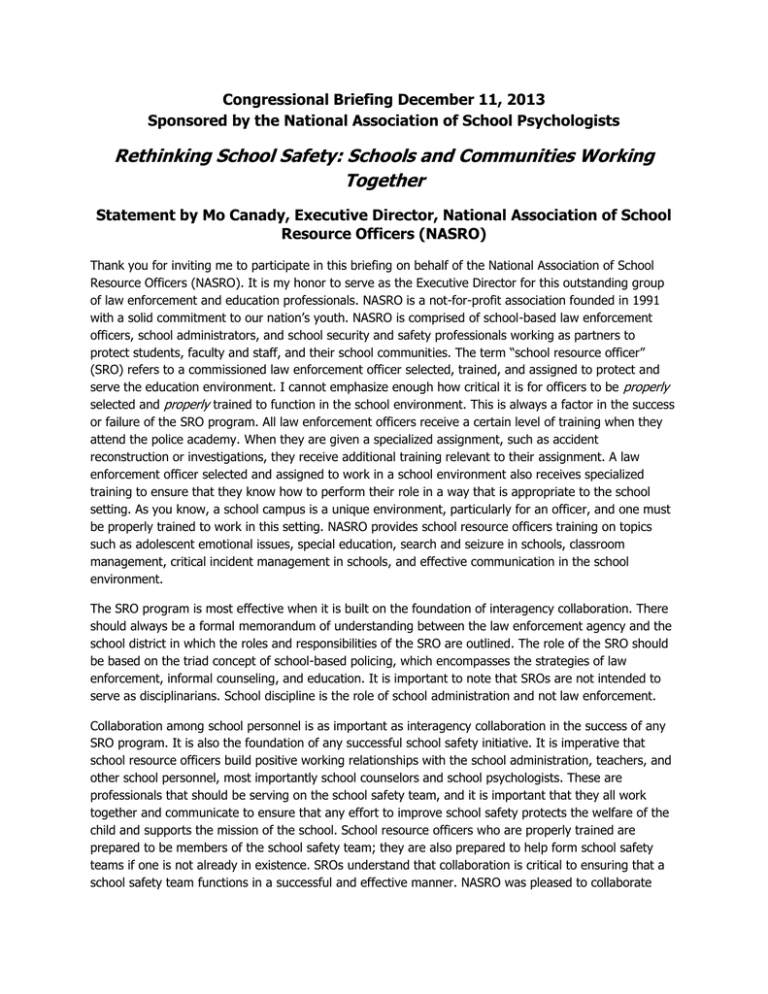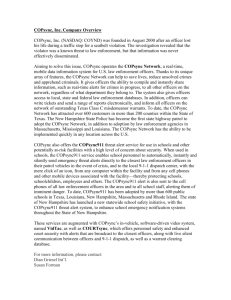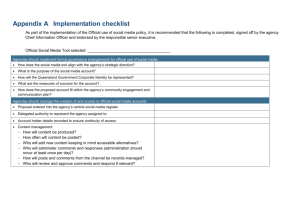Congressional Briefing December 11, 2013
advertisement

Congressional Briefing December 11, 2013 Sponsored by the National Association of School Psychologists Rethinking School Safety: Schools and Communities Working Together Statement by Mo Canady, Executive Director, National Association of School Resource Officers (NASRO) Thank you for inviting me to participate in this briefing on behalf of the National Association of School Resource Officers (NASRO). It is my honor to serve as the Executive Director for this outstanding group of law enforcement and education professionals. NASRO is a not-for-profit association founded in 1991 with a solid commitment to our nation’s youth. NASRO is comprised of school-based law enforcement officers, school administrators, and school security and safety professionals working as partners to protect students, faculty and staff, and their school communities. The term “school resource officer” (SRO) refers to a commissioned law enforcement officer selected, trained, and assigned to protect and serve the education environment. I cannot emphasize enough how critical it is for officers to be properly selected and properly trained to function in the school environment. This is always a factor in the success or failure of the SRO program. All law enforcement officers receive a certain level of training when they attend the police academy. When they are given a specialized assignment, such as accident reconstruction or investigations, they receive additional training relevant to their assignment. A law enforcement officer selected and assigned to work in a school environment also receives specialized training to ensure that they know how to perform their role in a way that is appropriate to the school setting. As you know, a school campus is a unique environment, particularly for an officer, and one must be properly trained to work in this setting. NASRO provides school resource officers training on topics such as adolescent emotional issues, special education, search and seizure in schools, classroom management, critical incident management in schools, and effective communication in the school environment. The SRO program is most effective when it is built on the foundation of interagency collaboration. There should always be a formal memorandum of understanding between the law enforcement agency and the school district in which the roles and responsibilities of the SRO are outlined. The role of the SRO should be based on the triad concept of school-based policing, which encompasses the strategies of law enforcement, informal counseling, and education. It is important to note that SROs are not intended to serve as disciplinarians. School discipline is the role of school administration and not law enforcement. Collaboration among school personnel is as important as interagency collaboration in the success of any SRO program. It is also the foundation of any successful school safety initiative. It is imperative that school resource officers build positive working relationships with the school administration, teachers, and other school personnel, most importantly school counselors and school psychologists. These are professionals that should be serving on the school safety team, and it is important that they all work together and communicate to ensure that any effort to improve school safety protects the welfare of the child and supports the mission of the school. School resource officers who are properly trained are prepared to be members of the school safety team; they are also prepared to help form school safety teams if one is not already in existence. SROs understand that collaboration is critical to ensuring that a school safety team functions in a successful and effective manner. NASRO was pleased to collaborate with NASP and several other organizations in writing the Framework for Safe and Successful Schools to highlight the important role of collaboration among organizations, and of individuals in promoting safe schools for all children. I spent nearly half of my law enforcement career in school–based policing, and it was without a doubt the most rewarding period of my career. To me, it was not just a job; it was my life’s work. I worked hard to develop positive relationships with administrators, faculty members, students, and parents. In my role as a school resource officer in Hoover, Alabama, I became an integral part of the school district crisis team. In this role, I was fully engaged in crisis planning to include prevention, preparedness, response, and recovery. This included assisting with the writing of crisis plans for the district, assessing the safety of school campuses, and assisting with conducting safety drills. It is important that any safety or crisis plan be practiced regularly, much like the way severe weather or fire drills are regularly conducted. It is very important for students and school staff to know what to do in the event of an emergency. However, it is also critical that these drills be conducted in a way that is not intimidating or frightening to students. Specifically, the more intensive drills, such as active shooter drills or large scale crisis response drills, must be conducted without students on campus. Crisis planning includes prevention, preparedness, response, and recovery. However, in the early phase of my career, I did not give a great deal of thought to the aspect of recovery. It was not until the days following November 19, 2002 that it became clear to me the importance of a well thought out crisis response plan, an effective school safety team, and a collaborative team, including the school resource officer, in the recovery of a critical incident. On that day, the unthinkable had happened at our largest high school: one student took the life of another in the hallway during the change of class periods. This is an incident that no school ever wants to face, but because the school had a solid foundation of crisis preparedness and response, we were able to address the issue and quickly move on to the recovery phase of this incident. Due to the nature of the crisis, we had a very large crime scene that took some time to secure. Our students had to remain in a modified lockdown for several hours, and although this was surely stressful for all involved, everyone did exactly as they were supposed to do, because everyone had been trained and the process had been practiced. I was asked by the principal to join him at a faculty meeting following the dismissal of the students. At that meeting, I praised the staff for their good work in the face of a difficult situation. Because of the school’s commitment to maintaining a solid school safety team, the school was prepared to respond to this crisis in an effective manner. In our case, our school safety team was comprised of school administrators, teachers, school-employed mental health professionals, nurses, students, school resource officers, and members of the fire service. This team would meet on a regular basis to discuss school safety issues, review safety plans, and conduct table-top exercises in order to be properly prepared to respond to a crisis. Because we had this solid foundation, the faculty meeting I just mentioned became the beginning of the recovery process for our school. We were able to develop specific plans for the next school day, but also for how we would begin to address to longer term needs of our students and staff. We knew that our most important job would be to keep something like this from happening again. We needed to make sure that we kept weapons out of the school and ensure that no retaliation for this act occurred. While all of those things were important, it paled in comparison to making sure that the mental health needs of the student body were met. Many students witnessed the event, many were grieving the loss of a life, and others were dealing with the shock that comes when violence hits our community. The need for trusted and caring adults, as well as those with the ability to provide mental health services to students and staff became the most important issue in this recovery process. The school resource officers in the district were certainly still focused on security, but we were also engaged in the mental and emotional recovery process. The reason for this is because we were much more than just a law enforcement presence. Because of the relationship we built with students and staff, we were viewed as trusted adults. We were able to provide emotional support to those who needed it, and make sure that those students and staff that needed more targeted mental health services were connected with the school counselors, school psychologists, school social workers, and community professionals. We helped to make a difference in the lives of children during the days prior to and most definitely following November 19, 2002. Trained and committed police officers are well-suited to effectively protect and serve the school community. School resource officers contribute by ensuring a safe and secure campus, educating students about law-related topics, and mentoring students as informal counselors and role models and collaborating with school staff to make sure that the needs of all students are met. Over the last 23 years, the National Association of School Resource Officers has become the world leader in school-based policing. We have trained thousands of police officers based on the Triad model of school-based policing, and these officers are having a positive impact on the lives of children on a daily basis. In order to facilitate the collaborative role of the SRO in school safety teams, it is important that Congress enact policy and dedicate a funding stream to ensure that communities are able to provide well-trained, highly qualified school resource officers across the country.






